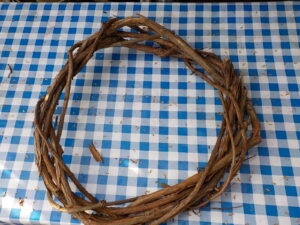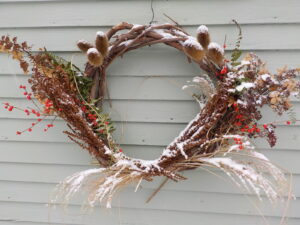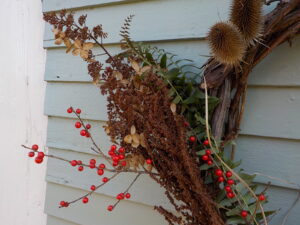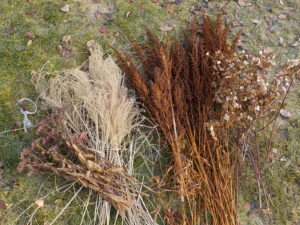Creating a Winter Wreath
Posted on Thursday, December 9, 2021 · Leave a Comment
Winter is upon us and it may seem there is little for a gardener to do. No weeding, nothing to plant, no flowers to pick. But last year’s garden may still have some remnants that, with a little imagination, can create something pleasing to the eye. I went out to my garden in early winter to see what dry flowers still were standing after my garden clean up, and saw plenty to work with. I picked plenty and set them aside for making winter wreaths and arrangements.

Wreath form made with grape vines
I like wreaths, and in the past I have made them to decorate an outdoor space such as a blank wall or door. Instead of using a wire wreath form, as many people do with evergreen wreaths, I used grapevines to make the basic form for my wreath. You can, too.
Go to a wooded area and look for vines climbing a tree. Grape vines are common in hardwood forests, but often strangle trees, so removing some grapevine is actually a good thing to do. Cut a 15-foot length of grapevine that is about as thick around as your ring finger. It is important to use living, not dead, vines; they are a greenish white inside and flexible. Dead vines are brittle, brown, and not suitable.
Begin by forming a vine circle 14 to 16 inches in diameter by overlapping (or twisting) one half of the vine over the other half – the same way you would start to tie your shoelaces. Then grasp one of the loose ends and weave it around the vine circle in loops, over and under, pulling it tight as you go. Then take the other end of the vine and weave it around the circle.
The great thing about this grapevine wreath is that you can just slide stems of dry flowers in between the vines and natural tension will hold them in place. In fact, I had to use a screwdriver to lift the vines at times in order to slide the stems in place. But I also use thin florists wire to tie together more delicate things like grasses and add them to the wreath.

Winter wreath with a dusting of snow
Here are some of the plants I used in my winter wreath. Sedum ‘Autumn Joy’ is a deep brown and stands up well in the winter garden. Fountain grass (Miscanthus sinensis) ‘Morning Light’ provides a light grown, fluffy material, as the seed heads are still present. Mine got knocked over by ice earlier in the winter, and then after the ice melted, it stood back up again!
What else? Various hydrangeas have flower panicles that are dry and delicate but still attached at this time of year. I used some flowers from one called ‘Quick Fire’. I like it for wreaths because the panicles are not huge, the way many of the PeeGee hydrangeas are, or Annabelle. If your panicles are too big, you can prune parts off to make them more suitable for a wreath.
I wanted some greenery in the wreath and could have pruned off some twigs from either white pine on hemlock, but had some Christmas fern right near the house and used that instead. I’m not sure how long it will hold up in a wreath, but looks good now. Hemlocks tend to drop needles fairly quickly, but anything used as a Christmas tree would be fine – Balsam fir or blue spruce, or example. Or snip some stems off your Christmas tree when you take it down.

Close-up of winter wreath
For color I went to my brook and gathered some winterberry (Ilex verticillata) growing alongside it. This shrub has bright red berries in winter, and although it prefers a moist location, but it will grow in ordinary garden soil, too. In summer it is pretty ordinary looking, but is fabulous when covered with red berries in winter. You need both male and female plants to get berries. One male is fine for five females.
The last addition to my winter wreath were some stems of teasel, a biennial weed hated by mid-western corn farmers. It gets in their machinery and gums up the works – and it grows 6 feet tall. The flowers and seed heads are two-inch cylinders that are very prickly. The stems have thorns, but these can be rubbed off while wearing gloves, making them easier to work with.
Because teasel is a biennial, it is easy to control: I pull most of the first-year plants when they are small. I leave just a few to grow and produce flowers. Six plants or so are nice. They stand up all winter and contrast well with the snow.
If you are not interested in making a wreath, or don’t have the time, pick some stems of anything interesting still standing in the garden, and put them in a dry vase. I leave some flowers with seed heads for the goldfinches and juncos to munch. Things like black-eyed Susans and purple coneflower are nice for them. I always leave some snakeroot, too (Actea racemosa., formerly Cimicifuga racemosa), as it is a tall plant that stands above the snow.

Dry plants cut for use in wreath
Lastly, if you are looking for dried flowers to decorate with, don’t forget the weeds. Walk through an un-mowed field and you will see plenty of dry flowers standing proud in the snow. Or take a walk along a country road and look for shrubby things with interesting branches or seed pods. With a little imagination, they can be used to create beauty.
Henry is the author of 4 gardening books and a long-time UNH Master Gardener. He lives in Cornish Flat, NH. Reach him by e-mail at
henry.homeyer@comcaset.net.






